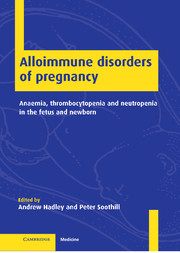 Alloimmune Disorders of Pregnancy
Alloimmune Disorders of Pregnancy Book contents
- Frontmatter
- Contents
- List of contributors
- Preface
- Foreword
- List of abbreviations
- 1 Pathophysiology of the alloimmune cytopenias
- 2 Blood group antibodies in haemolytic disease of the fetus and newborn
- 3 Basis and practice of screening for haemolytic disease of the fetus and newborn
- 4 Epidemiology and screening for alloimmune thrombocytopenia
- 5 Principles of antibody-mediated immune suppression and the prevention of maternal RhD alloimmunization
- 6 The clinical application of anti-D prophylaxis
- 7 Fetal genotyping
- 8 Laboratory assays to determine the severity of haemolytic disease of the fetus and newborn
- 9 Assessing the severity of haemolytic disease of the fetus and newborn: clinical aspects
- 10 Antenatal therapy for haemolytic disease of the fetus and newborn
- 11 Neonatal therapy for haemolytic disease of the newborn
- 12 The diagnosis of alloimmune thrombocytopenia
- 13 The immunological diagnosis of alloimmune neutropenia
- 14 Fetal and neonatal treatment of alloimmune thrombocytopenia
- Index
4 - Epidemiology and screening for alloimmune thrombocytopenia
Published online by Cambridge University Press: 26 October 2009
- Frontmatter
- Contents
- List of contributors
- Preface
- Foreword
- List of abbreviations
- 1 Pathophysiology of the alloimmune cytopenias
- 2 Blood group antibodies in haemolytic disease of the fetus and newborn
- 3 Basis and practice of screening for haemolytic disease of the fetus and newborn
- 4 Epidemiology and screening for alloimmune thrombocytopenia
- 5 Principles of antibody-mediated immune suppression and the prevention of maternal RhD alloimmunization
- 6 The clinical application of anti-D prophylaxis
- 7 Fetal genotyping
- 8 Laboratory assays to determine the severity of haemolytic disease of the fetus and newborn
- 9 Assessing the severity of haemolytic disease of the fetus and newborn: clinical aspects
- 10 Antenatal therapy for haemolytic disease of the fetus and newborn
- 11 Neonatal therapy for haemolytic disease of the newborn
- 12 The diagnosis of alloimmune thrombocytopenia
- 13 The immunological diagnosis of alloimmune neutropenia
- 14 Fetal and neonatal treatment of alloimmune thrombocytopenia
- Index
Summary
Background
Alloimmune thrombocytopenia is the commonest cause of severe neonatal thrombocytopenia. The pathophysiology and diagnosis of the disorder are described elsewhere (Sections 1.1.3, 1.3.3 and Chapter 12). Most cases are diagnosed after birth, hence the commonly used term neonatal alloimmune thrombocytopenia. However, there may be severe effects on the fetus in utero, and this, as well as the aetiology, may be emphasized through the use of the alternative term, alloimmune thrombocytopenia. In contrast to HDFN, alloimmune thrombocytopenia frequently occurs in first pregnancies.
Considerable progress has been made in laboratory aspects of platelet immunology since alloimmune thrombocytopenia was first recognized in the 1950s, allowing more precise diagnosis of the condition (Section 12.4) There have also been advances in fetal and transfusion medicine resulting in improvements in its management, particularly in the antenatal management of women with a previous history of pregnancies affected by alloimmune thrombocytopenia (Section 14.3). These advances in laboratory diagnosis and antenatal management have drawn attention to the fact that the first affected fetus/neonate in a family is only recognized after bleeding has occurred, and this has raised the question of screening for alloimmune thrombocytopenia.
The purpose of this chapter is to review the epidemiology of alloimmune thrombocytopenia and then to consider the case for antenatal screening against the criteria for screening programmes set by the UK's Department of Health National Screening Committee. Finally, areas where knowledge is still lacking, and where research effort should be directed, will be highlighted.
- Type
- Chapter
- Information
- Alloimmune Disorders of PregnancyAnaemia, Thrombocytopenia and Neutropenia in the Fetus and Newborn, pp. 61 - 72Publisher: Cambridge University PressPrint publication year: 2001


